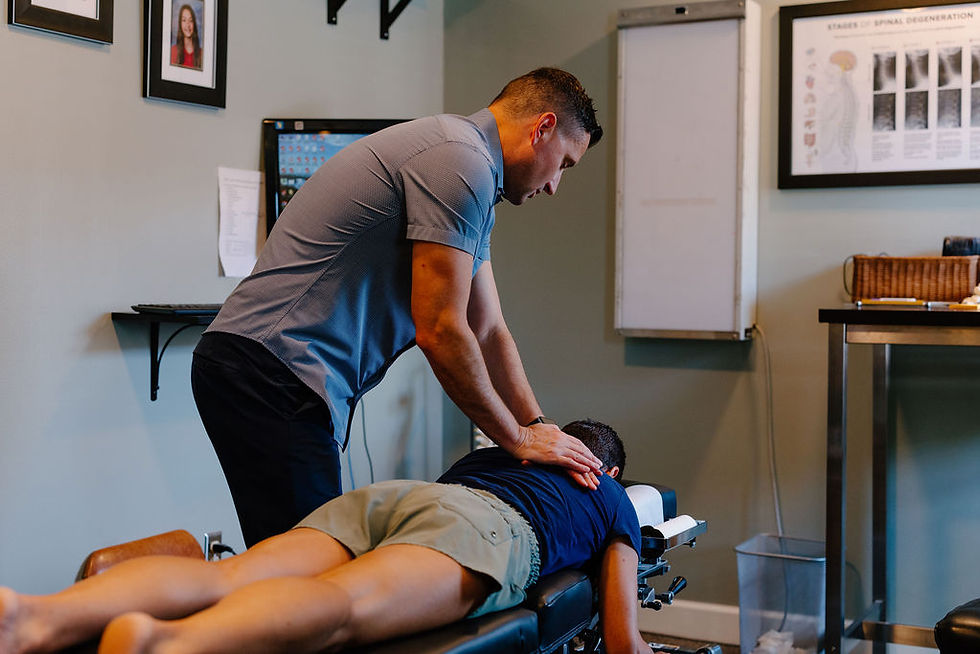Spinal Degeneration, Discs & “Dehydration”: A Plain-English Guide
- Atlas Rising

- Oct 29
- 3 min read
Today, we’re taking a quick dive into the nuts and bolts of spine health—a simple framework for what terms like degenerative disc disease, arthritis, bulging disc, and herniation actually mean, why they happen, and what you can do next.

First, the vocabulary
Degenerative Disc Disease (DDD): Gradual wear of the spinal discs (the gel-cushions between vertebrae). “Disease” is a misnomer; it’s a process.
Arthritis / Spondylosis: Extra bone formation (bone spurs) your body lays down to stabilize an overstressed joint.
Bulging Disc vs. Herniation: Think jelly-filled donut. With stress, the donut flattens and the jelly pushes out (bulge). If the inner “jelly” breaks through the outer ring, that’s a herniation.
“Slipped Disc”: Not a real slip—usually a bulge or herniation.
How degeneration actually develops
Curves & load:
Your spine’s natural curves distribute weight. Poor posture, sitting a lot, past injuries, or extra abdominal weight push abnormal forces into a few joints—most often the lower neck and lower back.
Motion = nutrition for discs:
Discs don’t have a direct blood supply. They “drink” nutrients and water via pressure changes when you move.
Less motion → fewer nutrients in → less water follows → the disc thins (what people call “dehydration”).
Then the cascade:
Thinner disc = tighter space = more joint stress → the body responds by laying down more bone (arthritis) to brace the area.
Key point: This change is usually silent for years. Many feel fine—until one day a simple twist, lift, or golf swing lights it up.

“If my discs are dehydrated, should I just drink more water?”
Hydrating your body is great, but it doesn’t directly rehydrate a disc. Discs draw fluid only when nutrients are pumped across the endplates—and that happens with motion and decompression, not just extra glasses of water.
Common ways this shows up
Stiffness that comes and goes, then sticks around longer
Local back/neck pain that flares with certain movements
Radiating pain, numbness, or tingling into an arm or leg (depends on which nerve is irritated)
Sometimes: no back pain at all, just limb symptoms
Red flags (seek urgent care): new/progressive leg or arm weakness, loss of bowel/bladder control, saddle anesthesia, significant trauma, fever/unexplained weight loss with back pain.
Can I stretch or exercise my way out of it?
Stretching and exercise are part of the solution, not the whole solution.
Once degeneration sets in, we still need to restore joint motion and space, calm irritation, and then build strength and endurance so it holds.
What actually helps (and why)

Get a proper assessment
History, exam, and X-rays when issues are recurrent or persistent. MRI is reserved for specific neurological findings or when needed to guide care.
Restore motion
Chiropractic adjustments improve segmental movement so discs can “drink” again. If disc spaces are significantly narrowed, spinal decompression can gently open space and reduce pressure.
Strengthen what stabilizes you
Core, glutes, hips, mid-back. Small stabilizers keep you upright; big movers help you lift. Both matter. Posture and ergonomic tweaks help your results stick.
Address load
Every 1 lb you lose (or gain) changes the load on your knees/hips/back by roughly ~4 lbs. Shifting 10–30 lbs can be a game-changer for pain and joint stress.
Live anti-inflammatory
Sleep, protein, fiber, micronutrients, and smart movement won’t “re-inflate” a disc, but they lower systemic inflammation so tissues heal better.
Expect a timeline
Discs heal slowly. For meaningful degeneration, think weeks to months (a common decompression plan is ~12 weeks). Consistency beats intensity.
Quick FAQ
Can arthritis be reversed?
Bone spurs don’t “un-grow,” but you can reduce pain, improve function, and slow progression by changing the forces that created them.
Why do my leg/arm symptoms show up without back/neck pain?
Irritated nerves can refer pain/numbness distally. Treat the source (the spine), not just the spot that hurts.
Do I need surgery?
Most people don’t. Conservative care (adjustments, decompression, targeted rehab) often calms symptoms and restores function. Surgery is for specific cases or failed conservative care.
Bottom Line
Degeneration isn’t a life sentence—it’s a signal. Restore motion. Reduce load. Rebuild support. Be consistent.
If you’re dealing with recurrent “tweaks,” radiating symptoms, or you’ve been told you have arthritis/DDD and want a plan, reach out. We can screen what’s going on, take images when appropriate, and map a step-by-step approach that fits your life.
This article is educational and not a diagnosis. We personalize recommendations after an exam and, when needed, imaging.




Comments